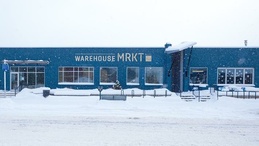
A Tough Row to Hoe
Michigan hemp farmers face challenges at every turn
By Lynda Wheatley | May 28, 2022
On a cold, drizzly Monday morning, Eric Dean sits hunched over a long folding table inside a cramped room on his family’s property in Williamsburg, doing what five generations of Deans have done here since before the Civil War: farming.
Eric’s careful work takes place in a temperature-controlled room, a windowless enclosure teeming with bright lights, whirring fans, and a veritable jungle of plants—hip-high, leafy bushes growing in buckets on the floor and petite sprouts growing from dozens of red Solo cups crowded on towers of shelves. Frankly, it doesn’t look much like traditional farming.
But after 162 years of successfully shepherding their land from one generation to the next and adapting their fields to the market’s changing demands—corn, wheat, rye, soybeans, dairy cows, beef cattle, chickens, pigs, and more—it’s safe to say the Dean family farmers share something more than a bloodline. They share a knack for keeping one eye on the soil below their boots and the other fixed firmly on the horizon ahead.
That’s why, in addition to growing hay and cherries like his family has for the last 50+ years, Eric convinced his parents in 2018 to add a crop that hadn’t been legal to grow in the United States since before he was born: industrial hemp.
The Wonder Weed
Hemp, you might say, built America. A quick-growing, regenerative source of food and extraordinarily durable fiber, hemp arrived in North America around 1545. Early colonists used it for building materials, clothing, ship sails, cordage, and so many other essentials that, by the mid-1600s, several colonies mandated its planters grow the stuff. It was one of the nation’s primary crops through the 1700s and 1800s.
In 1937, however, for myriad reasons which largely centered on the fact that hemp and marijuana are actually strains of the same plant—cannabis—President Franklin Roosevelt signed a bill that ultimately banned hemp production in America. Minus a brief period during World War II when the government did an about-face and encouraged farmers to grow “Hemp for Victory,” hemp remained planta non grata for the next eight decades.
That changed five years ago, when the Agriculture Improvement Act of 2018 legalized hemp production at the federal level. Michigan jumped on the opportunity, authorizing the growing and cultivating of hemp in 2018, then greenlighting an industrial hemp pilot program through the Michigan Department of Agriculture and Rural Development (MDARD) in April 2019.
Four years ago this spring, hundreds of first-time hemp farmers planted the state’s first legal hemp crops since 1937. What was predicted to be a mega-cash crop for Michigan farmers boomed and busted in short order, save for a few scrappy and savvy entrepreneurial farmers who are finding ways to keep their hemp farms profitable while they wait for government and other industries to catch up.
Oh, Pioneers
Eric and his parents, Dennis and Barbara Dean, are the founders of Lakeview Hemp and among the first to get in on Michigan’s hemp farming resurrection. Hundreds of others joined the Deans in nabbing licenses to grow and/or process the crop, all of them eager to get in on what looked to be the Michigan agricultural industry’s next big thing.
“Big” was not to be. Not in 2019, anyway. By harvest season, nearly half the 514 hemp licensees MDARD surveyed saw their crops destroyed—half due to crop failure, a third due to THC levels that were “hot” (i.e., not compliant with state and federal limits), and the rest due to complications from unexpected male plants, mold, mildew, or simply a lack of labor. Even growers like the Deans, who had successfully nurtured their first hemp crop from seed to healthy harvest, didn’t fare much better.
“We thought you could make around $50,000 an acre,” says Dennis Dean. “Just growing it in, cutting it down, and selling to some processor—and they’d just take it off your hands and give you 50 grand an acre for it. But nobody was doing that.”
The Deans weren’t alone—or naïve—in their optimism. According to reports in the Chicago Tribune and elsewhere, hemp flower alone was fetching $45,000 to $60,000 an acre in 2019, with some prices topping $100k.
You’d think the dismal results for Michigan’s freshman class of 21st-century hemp growers would prompt the farmers to cut and run. But hemp fever got hotter. In 2020, even more registered for licenses: 631 growers and 517 processors.
Then, in 2021, things cooled—a lot. Only 175 registered growers and 297 processors registered. This year, the numbers shrank again: 58 registered growers and 215 processors. (Those numbers could still increase a bit; unlike some states, Michigan allows its hemp growers and processors to register throughout the year.)
Dave Crabill, president of iHemp Michigan, says the promise of and possibilities for Michigan’s hemp industry remain huge, but lack of infrastructure, supply chain issues, and difficulty accessing capital investment top the list of obstacles for the state’s young hemp industry.
From Seed to Sold
The North American Industrial Hemp Council estimates that industrial hemp can be used to make more than 25,000 products. Livestock and pet food, horse bedding, salad oils, protein powders, paper, clothing, lubricants, paint, thermoset plastic parts, construction materials like bricks and stucco, erosion control mats, and biofuel are just a few.
But getting hemp from farm to market is no small feat. Take for example, hemp grown for what Crabill calls the state’s “ultimate goal”: fiber and grain. Initially, planting and raising the crop isn’t particularly labor-intensive. But once the growing season is over, the heavy lifting begins. The farmer can off the top third of the plant for grain, but because hemp is an oilseed, those grains need to be stored and aerated properly and immediately or they’ll spoil. The remaining stalk can become fiber. It’s chopped and left to rot in the field to encourage the outer part of the stem, the bast, to begin its natural separation from the inner part, the hurd.
Though the initial separation of bast and hurd takes place in the farmer’s field, stripping one from the other for their individual product destinations requires a process called decortication.
And that’s one place Michigan’s young hemp industry is getting stalled: Decorticating hemp in large amounts and transforming it into intermediary and end products requires massive processing plants and lots of them. Michigan simply doesn’t have that.
“I’ve spoken to a lot of auto manufacturers who are interested in using hemp for insulation in their door panels,” Crabill says, “but they want fiber, [not stalks].”
The math of the last few years then—hundreds of farmers with multiple acres growing 40,000 hemp plants per acre—adds up to a lot of unprocessed hemp with nowhere to go.
“We don’t have the contracts yet to grow. We need those commitments from folks like auto manufacturers for the crop so we can get the capital investment for the processing,” says Crabill. “But it’s what comes first—the chicken or the egg.”
Rather than send a crop to a large processor, could a farmer do it himself? Not easily. “Even on a smaller scale,” he says, “you need the equipment—and it’s at least $200,000 for the equipment to process [hemp into fiber],” says Crabill. As for bank loans, don’t count on them; even though hemp is federally legal, marijuana isn’t, and—again—both are cannabis.
Perhaps ironically though, that cannabis connection might be what sustains Michigan’s burgeoning hemp industry long enough to make it viable for bigger markets like food and fiber.
Option CBD
Right now, the most viable and lucrative market for industrial hemp farmers in Michigan is another hemp-born product: cannabidiol, aka CBD.
CBD is just one of at least 80 biologically active chemical compounds found in the cannabis plant and its second-most prevalent active ingredient. The first? CBD’s plentiful and more famous cannabinoid cousin, tetrahydrocannabinol, or THC, known to deliver a psychoactive, euphoric “high” to users who ingest, smoke, or topically apply it.
When Michigan got in on industrial hemp in 2018, Aaron Grenchik already had a decade of experience cultivating cannabis for a handful of medical marijuana patients, thanks to the passage of the 2008 Michigan Compassionate Care Initiative in 2008. Although not a farmer by trade—“My bread and butter is construction,” Grenchik says—the owner-operator of Williamsburg Construction Design Group launched Traverse City Hemp in 2019.
“It’s my belief that the cannabis plant possesses a lot of potential medical benefits. So, right from the get-go, I knew that it was something that I want to be involved in,” he says. “I really didn’t know specifically what direction I wanted to go in, apart from the fact that I wanted to grow a plant that had a high-yielding [CBD] oil content.”
As opposed to growing hemp for food or fiber, growing strains for CBD is far more labor-intensive. Farmers often plant and nurture their seeds in a controlled indoor environment ahead of planting season. They spend a lot of time cultivating the soil outdoors ahead of planting. Unlike the tall, densely-planted food and fiber cousins, the hemp seedlings and plants grown for CBD are planted by hand, about 5 feet apart, and meticulously watered, fed, and weeded to encourage an abundance of CBD-rich flowering buds.
Growing hemp for CBD is also costly. A report conducted through the University of Connecticut pegged the total cost per acre of hemp in 2020 (at 6.5 percent CBD) to sit somewhere between $13,000 and $19,289, with a profit of about $5,000 per successfully harvested acre.
The profitability depends greatly on the technical ability of farmers—how much dry flower they get and eke CBD from, the level of CBD in the crop, the market rate for CBD, and, of course, whether the crop makes it to harvest at all.
The Great Differentiators
Technical ability is one part of why growers like the Deans and Grenchik are still in the game while so many others have dropped out. (The fact that both already owned land and sizable structures required to dry, process, and store hemp certainly helps.)
The Deans and Grenchik have been licensed as growers and handlers/processors from the start. This enabled each business, Lakeland Hemp and Traverse City Hemp, to vertically integrate, taking on the processing of their own crops when no one else would, as well as creating products made from the CBD they’ve extracted.
Today, Lakeland Hemp and Traverse City Hemp each carry a substantial array of CBD products, and both confirm that despite the obstacles of being pioneers in a risky young industry, they’re seeing viability and watching their revenue grow year over year.
The hope is that the state catches up. Crabill says that raising the legal limit of THC even a smidge would make a huge difference for growers who invest so much time and money, then have to destroy an entire crop if it’s even 0.4 percent THC—which is still 20 to 30 percent less than in the average strain of marijuana on the recreational market.
Investment in the construction of processing plants around Michigan could be huge too, opening up the hemp industry to other promising and impactful industries, one of the most exciting being building materials, structural beams, panels, and bricks made with hemp—an area where Europe is leaps and bounds ahead of America.
For now, Grenchik and the Deans will keep planting, harvesting, and toiling to meet market demand where it’s most possible and profitable for hemp farmers in Michigan: CBD.
Dennis Dean has faith the tide will turn eventually. “The plant itself is one of the biggest remediators of carbon per square foot,” he says. Whether the government sees the promise of investing in processing infrastructure or not, he believes it’ll eventually recognize the massive impact raising hemp can have in lowering greenhouse gasses. “I have a feeling they’re going to be paying farmers to grow hemp one day.”
Trending

Welcoming the Winter Solstice: Rituals & Events for the Shortest Day of the Year
With the winter solstice quickly approaching, it’s hard not to notice how dark each day feels. Astronomically, this is… Read More >>
Camp Greilick Now Open!
It’s been a long road for the century-old Camp Greilick, which, after several dormant years, was acquired by Grand Tra… Read More >>
Men and Ugly Sweaters
Those two things don’t always go together, but on Dec. 19, you’ll see both out and about in Petoskey and Harbor … Read More >>


